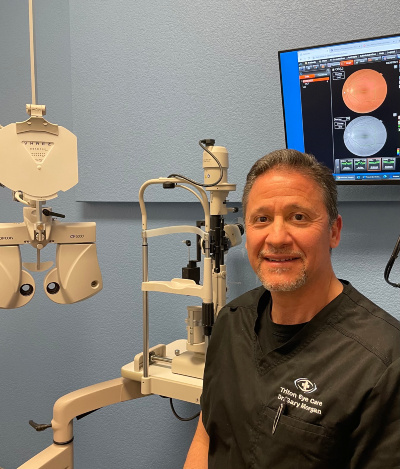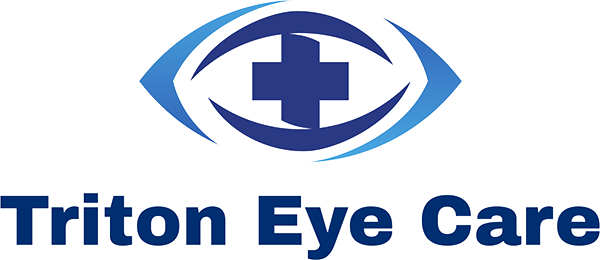 If you live in Prescott or the surrounding communities and wonder if there is an eye doctor near me that can manage all of my eye care needs, give us a call! Dr. Gary Morgan provides care for many eye conditions, including those listed below. Hovering your mouse over the blue words below provides a link to other information about the condition on our website.
If you live in Prescott or the surrounding communities and wonder if there is an eye doctor near me that can manage all of my eye care needs, give us a call! Dr. Gary Morgan provides care for many eye conditions, including those listed below. Hovering your mouse over the blue words below provides a link to other information about the condition on our website.
Age-related macular degeneration (AMD): Using a combination of state-of-the-art diagnostic technology and preventive techniques, Dr. Morgan works with each patient to maintain their best possible visual function. Light protection, optimizing nutrition with proper supplements, and regularly scheduled in-office testing are the cornerstones Dr. Morgan uses to help patients preserve their vision.
Allergies: Do your eyes itch? Does the skin of your eyelids itch? If so, you likely have a form of eye allergy. Itching located inside the eyelids is usually seasonal and can be severe. This is referred to as allergic conjunctivitis. Itching of the eyelid skin may be a localized allergy from exposure to an allergen or an overgrowth of the natural bacteria found on the skin. This is referred to as contact dermatitis. But take heart, you don't have to suffer from itchy eyes! Dr. Morgan can provide you with medications and a program for eyelid care to quell the itch.
Blepharitis: Each eyelid contains approximately 30 meibomian glands that produce oil for the tear film. These glands can become clogged with bacteria causing inflammation. The eyelids will become red irritated and may begin to have a dandruff-like flake. Other causes can be rosacea, or mites (called Demodex) living in the eyelash follicles. Treatment consists of cleansing with specialized eyelid cleansers, anti-inflammatory, and antibiotic medications. An examination can determine the cause and best course of treatment.
Bump on the eyelid: The sudden appearance of a lump or bump on the eyelid may be caused by a clogged oil (meibomian) gland in the eyelid. The orifice of the gland is clogged but oil is continually produced causing a lump. This is commonly referred to as a stye, but eye doctors call it a hordeolum. If bacteria, including the normal flora of the eyelid, get in the clogged gland, then swelling, redness and pain to the touch may ensue. Treatment consists of warm compresses and massage to express the gland, and oral antibiotics if there is an infection. While most hordeolum eventually resolve, occasionally a non-tender hardened lump may remain. This is called a chalazion, which if it is large or irritating may require surgical excision. Other bumps or growths on the eyelids can include viral papilloma or some skin cancers. It is good practice to have any new lump or bump on an eyelid checked out.
Conjunctivitis: Also known as pink eye, conjunctivitis is an inflammation or infection of the conjunctiva. The conjunctiva is a clear membrane that covers the white part of the eyeball and lines the inside of the eyelids. There are three primary causes of conjunctivitis, and depending on the cause, the treatment differs.
Viral conjunctivitis is similar to having a cold—there is no cure. But palliative treatment with cold compresses, antihistamine eye drops, and artificial tears can relieve the symptoms. Symptoms of viral conjunctivitis are redness and watering and can last up to two weeks. For severe viral conjunctivitis, in-office treatment with povidone-iodine followed by steroid eye drops can significantly reduce the symptoms and duration of the infection. It is important to know that viral conjunctivitis is extremely contagious, so it is best to avoid contact with others if you are diagnosed with it.
Bacterial conjunctivitis produces a thick mucus discharge along with redness and tearing. It is treated with prescription antibiotic eye drops and eyelid cleansing to remove the excess mucous from the eyelids and lashes.
Allergic conjunctivitis causes itching, as well as redness and watering of the eyes. Medications that were once by prescription but are now over the counter (OTC) can alleviate, as well as prevent the symptoms of allergic conjunctivitis. For severe cases, a short course of prescription anti-inflammatory eye drops can be used to supplement the OTC drops. Cold compresses can also bring symptomatic relief.
Diabetic eye exam: Diabetes affects the microvasculature throughout the body. Eventually, nerve tissue may be affected causing peripheral neuropathy. The two most common locations for diabetic peripheral neuropathy are the feet and the eyes. The eye is unique in that it is the only place in the human body that nerves and vasculature can be directly and non-invasively observed. During a diabetic eye exam, your eyes are dilated, and the doctor examines the retinal nerves and vasculature for signs of neuropathy. In the eye, neuropathy is referred to as diabetic retinopathy. Photographs and specialized scans of the retina may be used during the exam. If retinopathy is found, treatment consists of tighter control of blood sugar and monitoring. If the retinopathy is visually threatening, referral to a retinal surgeon for treatment with injectable medications, laser, or surgery may be indicated.
Dry eyes: The eye's surface is a complex microenvironment containing lipids, aqueous, and mucins. If any of the components become out of balance, dry eye disease may ensue. During a dry eye exam, ocular structures in the eyelids and surface of the eye are evaluated to determine the cause of dryness. Treatment is then directed at the specific cause of dryness. Cleansing, heat treatments, lubricants, nutritional supplements, and medications may all be part of dry eye treatment. However, treatment is just that--treatment. Unfortunately, there is no cure for dry eyes. But diligence by both patient and doctor can greatly improve the symptoms of dry eye and quality of life.
Floaters / Flashes: The posterior cavity of the eye is filled with vitreous gel. The vitreous is adhered to the retina, the light-sensing lining of the eye's posterior cavity. As we age, the vitreous gel slowly liquefies and shrinks, breaking areas of adhesion. These breaks cause debris, which we see as floaters. Large areas of the vitreous may separate, causing a sudden onset of large and or small floaters. This is referred to as a vitreous detachment. As the vitreous pulls on the retina during the detachment, flashes of light may be seen. Most times, this is a normal aging change of the eye. However, sometimes the vitreous detachment can cause the retina to tear or detach, which is a medical eye emergency. The retina can be repaired, but the sooner the repair takes place, the better the outcome. So, if you develop new floaters or flashes of light in your vision, see your eye doctor as soon as possible for a dilated retinal exam.
Glaucoma: Known as the 'sneak thief of sight,' glaucoma slowly (and unnecessarily) robs people of their vision. Glaucoma is a disease of the optic nerve with many potential causes. However, the mainstay of treatment regardless of the cause is lowering the intraocular pressure (IOP). During an eye exam, the optic nerve is examined for signs of glaucoma. If signs are seen, further testing is performed to evaluate the structure and function of the optic nerve. If glaucoma is diagnosed, treatment is started to lower the IOP. Depending on the severity, treatment consists of medications, laser, and intraocular surgery. All forms of treatment have advanced significantly in recent years. When caught early, the likeliness of blindness from glaucoma is low. When one loses vision from glaucoma today, it is usually from a lack of routine care. Yearly eye exams are the best deterrent against the 'sneak thief of sight.'
Pinguecula: If you have noticed a yellow jelly-like bump on the white of your eye, you likely have a pinguecula. Pinguecula is an overgrowth of the conjunctiva, kind of like a callous. They form from exposure to UV light, wind, and dust. While harmless, they can occasionally get irritated, usually from dryness. Artificial tears can usually provide relief. However, if a pinguecula becomes inflamed, it may become painful, and prescription anti-inflammatory drops can relieve the discomfort. Pinguecula is most common in those who spend a lot of time outdoors. Prevention includes wearing good quality sunglasses to protect the eye's surface from UV light, and frequent use of artificial tears.
Pterygium: Usually starting as a pinguecula, a pterygium becomes vascularized and may grow towards and onto the cornea. The cause of a pterygium is the same as a pinguecula, UV light, wind, and dust. Prevention is also the same, UV blocking sunglasses and artificial tears. However, if a pterygium grows toward the center of the cornea, surgical removal is warranted so that it does not affect vision.
Retinal detachment: The retina is the light-sensing lining of the inside of the eye. As discussed in the section above on Floaters and Flashes, the vitreous gel is adhered to the retina. When the vitreous shrinks and detaches, it can cause a hole or tear in the retina. Left untreated, a hole or tear can lead to a detachment of the retina. Trauma to an eye can also cause retinal holes, tears, or detachments. Symptoms of a retinal detachment are what seem like a veil or curtain in your vision, or loss of an area of peripheral vision. Treatment of a retinal detachment is surgical repair of the detachment. However, time is of the essence. The sooner a retinal detachment is repaired, the better the visual outcome.
Retinal toxicity: Several medications can cause toxicity to the retina. One of the most common is hydroxychloroquine (HCQ) which is also known by its brand name, Plaquenil®. HCQ is often prescribed for rheumatoid arthritis and systemic lupus erythematosus. HCQ toxicity in the retina is cumulative dose-related, meaning the longer one takes it, the greater the risk. In general, the risk of toxicity during the first five years of use is low. However, after five years, the risk increases. Therefore, baseline and yearly exams for the first five years of usage, and examination every six months thereafter are recommended. Toxicity from HCQ occurs in the macula, and specialized testing is used to determine if toxicity is present. The key to minimizing the risk of toxicity in the macula is to take the proper dosage based on body weight. To see more on retinal toxicity including proper weight-based dosage, click here to see our webpage on the topic.
Elmiron® is a drug that has been in the news for the last couple of years due to its potential to cause retinal toxicity in the macula. Widely prescribed for decades, Elmiron® is used to treat interstitial cystitis, which is pain in the bladder and pelvis that predominantly affects females. However, new studies are uncovering incident maculopathy from long-term Elmiron® usage. As it was previously unknown that Elmiron® can cause maculopathy, many times it was diagnosed as AMD. If you take Elmiron®, a thorough evaluation of your macula with specialized (OCT) testing should be performed.


